During November 1997 we returned to Australia from the UK via Goa in India for a two-week stop-over, this is an account of the avifauna recorded there during that period, hope you find this report as enjoyable as our holiday was, Homepage or see our report of our outbound trip to Malaysia in September.
 |
 |
|
|
|
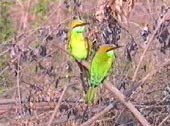 |
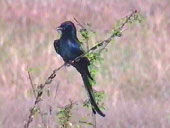 |
|
|
|
A pair of White-bellied Sea-Eagle appeared to
be nesting on the forested hill opposite Galgibaga Beach, Brown-headed
Gulls and Caspian Tern seen out to sea.
Mike managed to hire 2 scooters for Rp150/day
(Aus$6)and we used them to visit Cotigao Nature Reserve, we didn't even
make the reserve one day as we encountered a 'bird-wave' along the way
seeing some real gems such as Heart-spotted Woodpecker, Asian Fairy-Bluebird,
Velvet-fronted Nuthatch and several species of Drongo. Large Wood-shrike
were in good numbers here as were Scarlet Minivets.
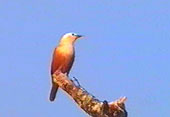 |
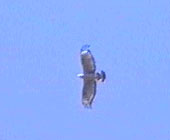 |
|
|
|
On another day we managed to get up early and
arrived at the Cotigao Nature Reserve HQ at dawn, narrowly missing an ID
on a flying Nightjar. We drove on further into the forest and Mike managed
to find a White-bellied Woodpecker drumming which I managed to film. As
the sun rose we kept the camera on a dead tree and got recordings of Crimson-throated
Barbet, Chestnut-tailed Starling, Scarlet Minivet and Yellow-throated Rock
Sparrow. Pompadour Green-Pigeon were flushed from fruiting trees and a
single female filmed. One species which was seen on several occasions here
was Rosy Minivet although there appears to be few recordings in the past
from other observers. Forest Wagtail
were present along the tracks but were very difficult to film. At the HQ
we saw one of the few raptors, a Crested Serpent-Eagle.
 |
 |
|
|
|
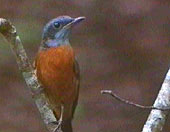 |
 |
|
|
|
The following day we had arranged to purchase
permits for the reserve at 0530-0600am (they normally open 0830am) but
were surprised when the office was still locked. Later the Ranger told
us that we were not allowed to enter the park without a permit and tried
to fine us!
By lunch-time we had seen virtually nothing,
strange in comparison with the previous day and decided to set-off for
Panjim and Baga on a luxury-coach recommended by some students. In Molem
we enquired about these coaches and met a variety of responses most saying
that luxury-coaches didn't stop at Molem! Eventually a policeman recommended
that the four of us wait with our luggage by the police-post for a normal
bus, and when one arrived the driver took one look at us and the luggage
and immediately bolted for his next destination! After about half an hour
Marie and I noticed a minibus driver expressing an interest in us near
the fuel-station and caught his attention. He told us he was actually on
his way to Panjim and would take us for Rp300 (the luxury-coach was supposed
to be Rp25!)
Fortunately after visiting a bank in Panjim
he took us on to Baga, where Marie had a list of hotels and guest-houses
that she had researched in Australia on the internet and in the Lonely
Planet Guide. We were quite surprised when the manager of the Villa Fatima
asked us where we had found out about his hotel as the driver was asking
for commission for recommending the place!
 |
 |
|
|
|
Tourist strip-Baga-Calangute-Fort Aguada-Morjim area
This area is part of the main tourist development
of Goa although our accomodation was still fairly cheap at Rp200/night
double room there are plenty of alternate places between Rp200-600/night
and birding trips to nearby areas are quite easy to arrange with local
minicab drivers from outside of the Hotel Beira Mar where we found most
package-tour birders were staying.
A visit to this hotel is a must in late-afternoon
as one can set-up ones 'scope, have a beer, tell other birders what they
have missed and see Painted Snipe and Cinnamon Bittern at dusk along with
a wealth of other species. From here I saw Black-capped, Stork-billed,
White-throated, Pied and Common Kingfisher, Marsh, Wood and Green Sandpiper,
Temminck's Stint, Crested Honey-Buzzard, Shikra, Large Pied Wagtail and
Blue-tailed Bee-eaters amongst many others.
The birders that we met at Molem had informed
us of Yellow-wattled Lapwing near the Riverside Hotel at Baga, and a walk
through the rice-paddies (mostly dry during our stay) found six of these,
Pied Cuckoo, Small Pratincole, several species of Bunting (including Red-headed)
and Pied Bush Chat. Pipits were a particular nightmare and the only species
of about 5 possibles that I managed to put a name to were Paddyfield. Indian
Roller and Little Green Bee-eater were fairly common and really add colour
to the area. Above the Reception at the Villa Fatima is a shrub with red
flowers which seems to be the only spot for Yellow-backed Sunbird that
we were aware of.
One day the four of us decided to visit
the famous Indian Pitta-site and took a one-way minicab to Fort Aguada
where we were informed we wouldn't find anyone to bring us back. Fortunately
there was a major bus-stop there but an unseasonal storm made birding difficult
initially.
 |
 |
|
|
|
The Pitta 'stake-out' is nothing short of an
open-sewer and sadly after 3 attempts we failed to see the bird, despite
others seeing it on the same day! We did manage to see Orange-headed Ground-Thrush
and Tickell's Blue-Flycatcher here though.
From here we walked up to the old Fort Aguada
and as the rain let up the birding became very exciting. The vegetation
here was just scrub but birdlife prolific, species seen included Spotted
Owlet, Indian Robin, White-cheeked Barbet, Olivaceous, Greenish and Booted
Warbler, Brown and Rufous-backed Shrike and White-browed Bulbul. Golden
and Black-hooded Orioles were common and Black-headed Cuckoo-shrike were
seen with Blue-winged Leafbird.
A single Blue Rock Thrush was seen by Mike,
Linda and Marie on a wall near the fort but this managed to evade me. A
raptor was filmed drying it's wings which I had identified as a juvenile
Imperial Eagle (a species I have some experience of in Saudi Arabia a few
years back) but there was some dispute of this and I believe they are fairly
uncommon in Goa.
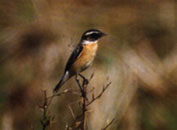 |
 |
|
|
|
Another site that we visited from Baga was Morjim,
supposedly good for gulls and waders, we took a minicab at Rp500 return
with a local driver who new the sites but were a little disappointed when
we found only Greater, Mongolian and Kentish Plover roosting and Brown-headed
and Greater Black-headed Gulls with Sandwich and Crested Terns offshore.
Harris recommends researching tide times in his guide, something we didn't,
too our cost.
Probably the most exciting day out from
Baga was a trip I made with 3 other birders to Carambolin Lake. Just east
of the town of 'Old Goa' Carambolin Lake is lily-covered and has an enormous
amount of waterfowl, many egrets and heron in the centre, Purple Gallinule,
Bronze-winged and Pheasant-tailed Jacana and thousands of Garganey, Wigeon,
Pintail, Common Teal, Shoveler and exotics such as Comb Duck and Cotton
Pygmy-goose. Raptors such as Marsh Harrier and White-bellied Sea-Eagle
flush these frequently so things are never too static. In the surrounding
area we came across Greater Coucal, Jungle Babbler, Indian Robin and about
2-3kms away through Carambolim village we caught up with the unusual 'saxicola'
species that is regularly sought and currently thought to be Stoliczka's
Bush Chat (a Red-Data listed species) Another uncommon species which we
saw here in large numbers (c.500+)was Small Pratincole, although the flock
was difficult to get access too.
Close to Carambolim is the Ciba-Geigy Chemical-Works,
the company has created a pleasant nature reserve in response to environmental
concerns and is the top site in Goa for Lesser Adjutant (12) and Open-billed
Stork (16) also present was a single White-necked Stork, Purple and Grey
Heron, Indian and Little Cormorant and Marsh Harrier were also observed
here.
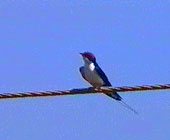 |
 |
|
|
|
On a more sober note whilst there we had
first-hand reports of a female birder being mugged on the trail up 'Baga
Hill'. Whilst this was probably the first-ever such occurence
the indifference shown to her by the local police is rather alarming, although
some of the local hotel-owners seemed to be concerned as their occupancy
rates are already declining. The general opinion seemed to be that the
thieves were probably drug-habit motivated, so caution should be taken
in this area and near the covered bridge by the Riverside Hotel.
On the whole though, Goa is an incredibly
friendly place and the locals very helpful.
So ended an excellent two weeks birding,
mention should be made of meal prices in Goa, we ate wonderful food (I
was the only 'digestive casualty' having only had a brief half-day with
the 'trots') and a meal for four with beer or wine usually came to around
Rp600 (around Aus$24!)
In November 1997 a two-week package to Goa
with full board could be had from the UK for 250-350 Sterling Pounds.
We would just like to send thanks to all
those who helped and 'birded' with us in Goa and sent info via the internet.
We hope to catch up with Michael Knolle, Nick and Corazon, John Wilson
and his wife and the 'lads from Yorkshire on our 'patch' in Queensland
in the near future. A special thankyou to the people of Goa who made our
holiday great!
Tom and Marie Tarrant, Lot 10, Watson Rd, Samsonvale, Qld 4520, Australia
Number of visitors to this page since it's inception 30 Jan 1998